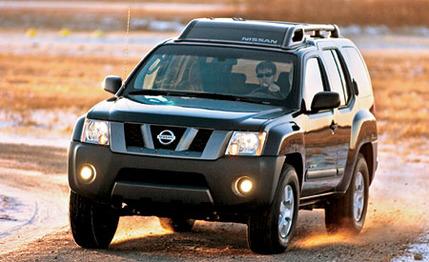
 Road Test
Road Test
The first-generation Nissan Xterra was, to be blunt, a passable product wrapped in a great idea. Think of it as the Twinkie of small sport-utes-not the best merchandise overall for consumption, but damn if it didn't hit the spot. Available between 2000 and 2004, that original Xterra was built around the Frontier pickup's ladder frame-a dated platform comprised of C-section rails made from conventional steel-and came with an available V-6 engine that was not only down on power (even the new-for-2002 supercharged 3.3-liter SOHC 12-valve mill put out a middling 210 horses) but also about as refined as raw sugar.
But all that was trivial, we're told, in the eyes of active-lifestyle junkies, both genuine and wannabes. To them, Nissan had created SUV utopia with the Xterra's blend of a sub-$20,000 starting price, blistered sheetmetal, and genuine functionality for extreme activities. After all, it had the luggage nets, the first-aid kit, and the available interior bike rack to prove it, not to mention the roof-mounted storage compartment designed for dirty dungarees or wet waders. The Xterra was a sports locker on wheels, and Nissan held the combination.
But since the Xterra's debut five years ago, automakers such as Jeep, Kia, and Land Rover have attempted to copy Nissan's recipe. And why not? The Xterra has been relatively alone in the compact-brute-ute segment, and its sales have never dipped below last year's total of 66,690. Obviously, Nissan is on to something.
To keep the corporate boulder rolling with the second-generation Xterra, Nissan created a beefier look-alike that retains the original's trademarks-a stepped roof with an integrated rack and storage compartment, a liftgate bubble that houses an optional first-aid kit, and an interior with enough cubbies, nets, and tie-downs to make a spree at Costco no sweat-yet builds on those offerings with a latchable and removable lid for that roof-mounted box, a durable plastic covering for the cargo floor and the backs of the 60/40-split second-row seats, and rear side bumper steps to ease loading and unloading gear to and from the roof rack. And most important, the Xterra now features an all-aluminum DOHC 24-valve V-6 and a version of the brand's stout F-Alpha platform, which utilizes stronger, fully boxed frame rails, many of which are made from higher-strength and lighter-weight steel, a move made to offset the new Xterra's higher weight. Our tester weighed 4456 pounds, 265 more pounds than a V-6 Xterra we tested in 2001.
For this generation, Nissan has created new trim levels: the entry-level S, the hard-core Off-Road, and the premium SE. Each comes standard with a potent 265-hp, 4.0-liter V-6 engine, two-wheel drive, and a six-speed manual transmission. Optional are four-wheel drive and a five-speed automatic transmission. Best of all, Nissan says pricing will hover around current levels, which means a new S will start at $21,380, the Off-Road at $23,780, and the SE at $25,880; and add about $2000 to those prices for four-wheel drive.
For our road test, Nissan lent us an Off-Road 4WD equipped with the standard six-speed and the optional part-time four-wheel drive with a low range. The Off-Road 4WD differs from other trims in that it gets BFGoodrich Rugged Trail tires, a locking rear differential, Bilstein shocks, three skid plates, black body-side molding, and blue fabric seats. And because it's the rock climber of the group, the Off-Road gets more generous approach and departure angles (33.2 and 29.4 degrees, respectively) and is the only trim available with hill-descent control and hill-start assist, both standard with automatic-transmission-equipped versions. The former holds speed downhill while the latter prevents rolling backward on an incline when off the brakes. Our three-pedaled tester also featured a clutch-interlock-override button that makes daunting maneuvers less scary by alleviating the use of the clutch when starting the vehicle and performing first-gear crawls. Although we weren't able to subject our Off-Road example to the type of terrain that carries its name, editor-at-large Patrick Bedard drove an Xterra over the rough-and-tough stuff at a press preview and had no problem conquering every rock, stump, rut, and hill that was placed before him [C/D, February 2005]. For this test, we focused on where most Xterra buyers drive their vehicles-the pavement.